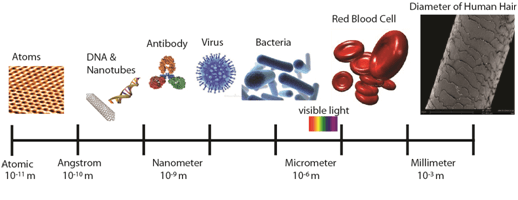It’s hard not to find news on nanotechnology and its impact on products we use every day. Emerson’s Robert Ferris, Ph.D., will share a series of posts in the coming month that will provide a balanced review of what nanotechnology means to you and your business’ customers.
Robert is a strategic planner with Emerson Process Management. He holds a bachelors and masters in Chemical Engineering, an MBA in new technology commercialization, and a Ph.D. in Mechanical Engineering and Materials Science. He has an extensive background in nanotechnology development and advanced process control.
Hello and Welcome
Nanotechnology has been a buzzword for a number of years now. People have written tomes about the coming nanotechnology revolution. A short time spent searching the internet or reading Wikipedia will reveal thousands of articles written about the potential advantages to come. Focusing on the future advantages, however, has distracted everyone from what is being done today with nanotechnology.Today, most people do not know how nanotechnology is being used or why they should care. This series of blog posts is focused on explaining the tangible improvements nanotechnology has delivered to manufacturers, customer, and process automation suppliers such as Emerson.
I contribute the knowledge gap to the fact that most of the writing out there is written by science-brains and first-adopters. Previous authors focus on the technology and potentials of bench-top scale innovation. This is great for the fellow science-brain but useless to the general population. I can say this because I am one of those science-brains.
The unfortunate truth is that most people do not understand nanotechnology nor care about the science behind it. They only care if the new product is better than the last. Nanotechnology is not a value proposition. So, the articles written do not focus on what the general population cares about. Instead, people are confused by nanotechnology and as a result are unsure of how it can be used.
This blog series is focused on bridging the knowledge gap by translating nanotechnology topics into meaningful, business-focused information. I’ll address topics that people can use in their various roles across Emerson, including: legal implications, product management, technical marketing, industry trends, and government regulations. Translating a technological innovation into something of value hopefully, will clarify what nanotechnology can do for you and your customers.Relative sizes of naturally occurring items. The nanometer length scale is a thousands times smaller then bacteria and ten million times smaller than the width of a human hair.
Nanotechnology is not new; in fact, it was used as far back as the 16th century in stain glass windows. Also, nanotechnology is already being used in products today, ranging from consumer goods to food processing. Don’t be surprised if you didn’t know, a lot of companies do not publicize the fact that they use nanotechnology. You only saw tennis rackets get lighter and stiffer or low-fat milk get tastier. Products have been getting better all along and most people just think that is normal.
The difference now is that products are getting better through nanotechnology. If you think about it, nanotechnology is only a natural evolution of process control. For example, to make a plastic pressure meter casing withstand more rugged environments, we must improve the material properties. This means that we have to control the material structure over smaller and smaller length scales. To do this, you inevitably push manufacturing control capabilities into the nanometer length scale. For example, by manufacturing with nano-scale precision we can improve the durability of plastics in extreme hot or cold conditions. The improvement in reliability or precision is what we take to our customers. We have come to expect such product improvements – what we did not expect were the amazing new properties we can access through nanomanufacturing.
No nanotechnology blog should disregard the regulatory, social, and environmental risks that are being faced through nanotechnology. Many companies and industries are adopting nanotechnology, but there is a great deal of uncertainty about its implications and ramifications. While industrial innovation proceeds regardless of this uncertainty, many regulatory agencies struggle to keep up. As such, each of these posts will take a pragmatic approach, discuss multiple sides of the issue and leave it to you to decide. I hope you enjoy these posts as much as I do writing them.
Stay tuned: My next post will address marketing of nanotechnology and how to translate it into something valued by your customers.
We hope you’ll share your opinion or questions! Add a comment below to provide your thoughts, insights, or questions for Robert.





